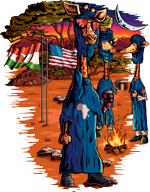Traveling overland in Niger, especially in the Sahara region around Agadez and Gadoufaoua, is an adventurous but challenging endeavor due to the remote desert terrain, extreme heat (up to 50°C/122°F), shifting sands, and potential security concerns. Gadoufaoua, known as the "place where camels fear to go" in Tuareg legend, is a vast 100-mile (160 km) stretch of the Ténéré Desert in the Elrhaz Formation, famous for its Cretaceous-era dinosaur fossils like Ouranosaurus, Nigersaurus, and the massive SuperCroc (Sarcosuchus). The distance from Agadez to key fossil sites in Gadoufaoua is approximately 160-200 km (100-125 miles), but there's no paved road—it's all off-road tracks through dunes and rocky plains, taking 1-2 days one-way in a 4x4 vehicle.
- Permits and Security: Arrange a mandatory armed military escort through NTT. This is non-negotiable for safety. Also we obtain a paleontology site permit if planning to visit active digs
- Transportation: Self-driving is possible but risky without experience.
- Health and Logistics: Bring ample water (5L/person/day), food, sunscreen, hats, and a satellite phone/GPS (e.g., Garmin inReach). Vaccinations for yellow fever, malaria prophylaxis, and travel insurance covering evacuation are required. Best time: October-April (cooler dry season).
- Accommodation: Basic bush camping (tents, sleeping mats) or return to Agadez hotels like Hotel Tidam.
Day 1: Agadez to Mid-Desert Camp en Route to Gadoufaoua (Travel and Initial Exploration)
Morning: Departure and Desert Traverse (~100 km, 6-8 hours driving)
- Start at 6 AM from Agadez (after breakfast at your hotel and final permit checks at the tourism office). Meet your Tuareg guide and military escort (1-2 soldiers in a separate vehicle). Load up with water, snacks, and fossil-hunting tools (brushes, notebooks—leave heavy digging to pros).
- Head northeast out of Agadez on sandy tracks toward the Ténéré Desert. The route follows ancient caravan paths (pistes) through acacia-dotted plains, passing the Telwa Wadi (dry riverbed) and small Tuareg villages like Azel. Expect bumpy off-road driving—navigate ergs (dune seas) and gravel hammada (plateaus). Your guide will share stories of Tuareg nomads and the "Green Sahara" era when this was lush with lakes and hippos.
- Stop midway (~3-4 hours in) at a scenic viewpoint for photos of petrified tree trunks and eroded badlands hinting at ancient riverbeds. Spot wildlife like fennec foxes or desert gazelles if lucky.
Afternoon: Arrival at Fossil Outskirts and Light Exploration (2-3 hours)
- Arrive at the western edge of Gadoufaoua by early afternoon (coordinates ~16°50'N 9°25'E). This "dinosaur graveyard" reveals itself with wind-sculpted sandstone cliffs and scattered bone fragments eroding from the Elrhaz Formation (115-125 million years old).
- Guided walk (1-2 km) to a surface scatter site: Hunt for exposed fossils like crocodile teeth, fish scales, or dinosaur vertebrae (no digging—sites are protected). Learn from your guide about Paul Sereno's expeditions, which unearthed SuperCroc here in 1997 (a 12m/40ft man-eating croc that preyed on dinosaurs). The heat is intense, so stay hydrated and stick to shaded breaks.
- If time allows, visit a nearby pond deposit with tiny mammal bones, evoking the wetter Cretaceous world.
Evening: Bush Camp in the Desert
- Set up camp in a sheltered wadi (dry valley) amid dunes for sunset views. Enjoy a Tuareg-style dinner (goat stew, couscous, dates) cooked over a fire. Stargazing is phenomenal—no light pollution. Overnight in tents; temperatures drop to ~15°C/59°F. Distance covered: ~100 km. (Meals: Breakfast in Agadez, lunch/packed, dinner camp.)
Day 2: Deep into Gadoufaoua Fossil Sites and Return to Agadez (Exploration and Traverse Back, ~200 km round-trip from camp, 8-10 hours total)
Morning: Core Fossil Dig Exploration (~50 km deeper, 3-4 hours driving + 2-3 hours on-site)
- Rise at dawn (5 AM) for tea and a quick dune walk. Drive deeper into Gadoufaoua to a key dig area, like the Ouranosaurus "sail-back" sites or Nigersaurus bone beds (a bizarre "vacuum-mouthed" sauropod). The escort vehicle follows closely.
- Spend 2-3 hours at the site: Guided tour of exposed quarries and replicas (real bones are often in museums). Brush away sand to reveal fragments—imagine 110-million-year-old spinosaurs wading in ancient lakes. Your guide can point out trackways or SuperCroc armor plates. Discuss the site's biodiversity: crocs, turtles, and massive herbivores in a river delta ecosystem.
- Break for a shaded picnic amid the "seas of sand," probing for hard terrain to avoid getting stuck.
Afternoon: Return Journey to Agadez (~150 km, 5-7 hours)
- Depart by noon to beat the peak heat. Retrace tracks but detour for a nomad encounter (Tuareg herders with camels) or a quick stop at Gobero (nearby ancient human burial site from the "Green Sahara" ~8,000 years ago—skulls and tools preserved in dunes).
- The drive back winds through shifting sands; expect deflations (sand bowls) and possible minor detours. Arrive in Agadez by late afternoon/evening, dropping off the escort.
Evening: Relax in Agadez
- Check into your hotel (e.g., Hotel du Sahel for Tuareg vibes). Debrief with your guide over mint tea and dinner at a local spot (try brochettes and taguella bread). Visit the Grande Mosquée or camel market if energy allows. Reflect on the "lost world" of African dinosaurs. (Meals: Breakfast/lunch camp, dinner in Agadez.)
Contact NTT for Pricing
“Dear Sasha and Chris,Yesterday we came back home after our African trip.And I would like to use this opportunity to thank You for the organization of our excursion in Niamey and for the work of Hassan and Your English speaking guide.Best regards,”
- Vladimir, Cure Salee Festival and Custom Niger Tour










